It must have felt like summiting a mountain, exhaustion and jubilation at war with each other, only to discover that, well, actually this isn’t the summit yet – and now you have farther to go than you can possibly manage.
In the fall of 2019, Inland Woods + Trails (formerly Mahoosuc Pathways) – an organization staffed largely by volunteers dedicated to extending and maintaining multiuse recreational forest trails around the area of Bethel, Maine – had just created the Bethel Community Forest, whose 978 acres were braided with trails connecting downtown Bethel to the Sunday River ski resort in Newry. The little nonprofit had completed an intensive, multiyear fundraising campaign to buy that land.
“We had a huge celebration surrounding the opening of the forest,” said Executive Director Gabe Perkins. “Senator Susan Collins and a number of other dignitaries were there. Then later that very same week somebody came up to me and said, ‘Did you see this?’”
“This” was an online listing for a new piece of property for sale – specifically the 15,412-acre Chadbourne Tree Farm, whose logging operations for generations had been one of the prime economic engines for that part of the state. This was not a typical tree farm, but a fragmented, far-flung sort of property. Divided into 45 parcels that on a color-coded map looked like dabs of paint flung from the sweep of Jackson Pollock’s brush, its lots spattered widely along the course of the Androscoggin River, gathered more closely around Songo Pond and the headwaters of the Crooked River, and clumped up on either side of the town of Bethel and down the Crooked River into Albany and Waterford.
Among those parcels was land crucial to the achievement of Inland Woods + Trails’ next great objective: trails from downtown Bethel to that other neighboring ski area, Mt. Abram in Greenwood. Perkins had hoped there might be a way, eventually, to buy just that connecting land from the Chadbourne family. But now, via auction, the entire tree farm was on the market to the highest bidder.
Other local conservation organizations were concerned about the listing as well. The Western Foothills Land Trust (WFLT), for example, seeks to protect forests, farmlands, watersheds, and ecosystems in that region’s Oxford Hills area. “There was a general apprehension throughout this part of Maine about what might happen when Bob Chadbourne decided to retire,” said Lee Dassler, the trust’s executive director. “With all that land put out for bid at once – well, it limited who the players could be. Not the locals, certainly.”
The tree farm had been assembled patiently over the course of 150 years by the descendants of William Chadbourne, who in 1634 was sent by London’s Laconia Company to build what may well have been New England’s first water-powered sawmill in South Berwick, Maine. Later generations of Chadbournes moved to Bethel, where they harvested and milled logs – primarily eastern white pine – from their own lots for their sawmills, and also sold veneer and pulpwood. The tracts they bought were staked out in small bits and large pieces, hither and yon, according to such factors as the quality of the pine and the distance from their mill in Bethel.
“Oh, it’s beautiful land,” said Dassler. “You drive into Bethel, you see those forested hills all around you, and it just makes you breathe deeper.”
The ancient, towering pines that English monarchs claimed as ship masts for their navies were the first to come down. Those that lingered rarely survived the widescale cutting of the first half of the 19th century. An 1839 article in The Yankee Farmer and New England Cultivator, for example, noted a remarkable remnant stand of 150-foot pine trees that were cut and turned into dugout canoes.
“You couldn’t consider the Chadbourne lots to be truly exemplary pieces of oak/pine forest because they’ve been logged continuously for a very long time,” said Brett Engstrom, a botanist who has done fieldwork on the tree farm. “But in these lots the cuts have been selective – no patch cuts – and not at all heavy-handed.”
Indeed, the Chadbournes, for the most part, did not turn their lots into plantations, but rather allowed them to remain botanically diverse. They pruned the lower limbs from their pines to ensure a yield of long, knot-free boards, but pines will ultimately self-prune over time as they grow in height. And the Chadbournes – who in 2014 were awarded Maine’s Austin H. Wilkins Award for forest stewardship – harvested selectively, not according to age or size, but rather health, flagging the trees that showed early signs of rot or infestation, or had suffered logging or wildlife damage. “So in fact, relatively speaking,” said Dave Degruttola, a Bethel-based forestry consultant, “you’ll find some very tall, very old trees on these lots.”
Selective cutting such as this is the equivalent in silviculture to organic farming. It results in a healthier, more resilient forest, one more resistant to the effects of climate change and other threats. Even more appealing about these lots to conservation organizations, however, is their range of locations, from high on the hillsides down to the river valley bottoms.
“It’s not hard to find land up in the higher elevations that might be bought for conservation purposes,” said Brett Engstrom. “Those are places where nobody lives and might not be used much except by loggers. But down in the valleys of rivers like the Androscoggin, you’ve got agriculture and population density and heavy usage. So to have an opportunity to buy as much land as this for the purpose of conservation, well, even a thousand acres of forest like the Chadbournes’ is very hard to find.”
Between the Androscoggin and the Crooked – and their tributaries – these 15,000 hillside and valley bottom acres include 33½ miles of river frontage. And it is there in particular that forest communities support life as we know it. Trees everywhere – but most productively those along coasts, rivers, and other bodies of water – are the pumps that draw water from the ground and then, through their foliage, release the excess in the form of vapor, vapor that condenses into the clouds that water inland areas and feed watersheds.
Forests are the sine qua non of keeping the water cycle cycling, and each lost forest is one more significant reduction in capacity – and especially so with those hard-to-preserve, easy-to-lose forests abutting rivers.
The International Union for the Conservation of Nature (IUCN) estimates that forests suck some 2.6 billion metric tons of carbon from the atmosphere each year. Older, bigger trees are of premium value in this regard; they not only absorb more carbon, but they grow faster than younger trees. Then the “waste” produced by trees – the leaves or needles they continuously grow and shed – fertilizes and sustains the foundational biomes of the forest floor and contributes nutrients to streams and rivers.
And just as forests play a purifying role in the carbon cycle, they also play such a role in the water cycle – not just in the vapor they breathe out, but in the bulwarks they represent against development and consequent pollution from industrial or residential activities along waterways. In southwestern Maine, 2,867 acres of the Chadbourne property lies within the Crooked River watershed, which ultimately feeds into Sebago Lake. This lake in turn supplies water to the city of Portland and to one in six Maine residents. This is pristine water indeed, drawn from one of just 50 public surface-water supplies in the United States that require no filtration before treatment.
In ecological terms, all of the above describes why such local nonprofits as Inland Woods + Trails, the Western Foothills Land Trust – and also the Mahoosuc Land Trust (MLT), which focuses on the Bethel area – covet forested land when it comes up for sale.
And their small scale explains why they have limited options when big chunks hit the market. “All we could do in 2019 was wait to see what would happen,” said Lee Dassler. “And then we started to get communications from The Conservation Fund.”
With its dual charter to pursue both environmental conservation and economic development, The Conservation Fund (the Fund) is a national organization that shares a conviction common to these local outfits: that in the long run the protection of forests is as good for the economy as it is for the environment, and that in both the present and the future such ongoing uses as logging – if done sustainably – is of no grievous harm to a forest, and of great value to hard-pressed rural communities.
And the Fund has the resources to act on this conviction. “Well, for conservationists to have a chance, you have to be able to compete in the marketplace with the timber companies and developers,” said Tom Duffus, who has been representing the Fund in the Northeast from his base in Maine since 2015. During the past 10 years, through a combination of philanthropic and investment capital, the organization’s Working Forest Fund has grown competitive enough to do just that, securing more than 754,000 acres of working forest around the nation (more than 8½ million acres have been conserved nationwide by the Fund since the organization’s founding in 1985, including more than 466,000 acres in Maine).
But the Fund’s goal is not to own and manage forestlands long term, per se. Rather it seeks to serve as a bridge to the sort of ownership pledged to their permanent protection. Through its Working Forest Fund, The Conservation Fund is able to buy large tracts of working forest. Then, the Fund typically attaches conservation easements to those tracts, or sells land in fee to local private or public owners committed to sustainable management. Easement lands are typically sold back into the working forest marketplace. As part of the Chadbourne Tree Farm deal, the Fund is working on placing 10,000 acres of forestland under conservation easement to support their use as traditional working forests while retaining ecological and public recreation values, before these tracts go back on the market. For smaller lots having high conservation values attractive to such local organizations as the WFLT or Inland Woods + Trails, the Fund will buy the land and hold it on a promissory basis while the money gets raised for their repurchase.
So began a whirlwind courtship here between the national nonprofit and several local little ones, a romance conducted under media silence in case it all fell through. “We had to spend a lot of time explaining from a local perspective what community needs and goals would be served by a purchase of this sort,” said Gabe Perkins. Soon Lee Dassler was shown that color-coded map of the Chadbourne tracts and asked by Duffus which of those tracts would be most helpful to what the WFLT was trying to accomplish. “But I couldn’t even whisper to my board members what was going on,” she said.
In October 2019, the Fund submitted its bid. In January, Bob Chadbourne, 11 generations removed from his ancestor William, announced that the family had their buyer, saying, “I’ve really loved this land, but we just thought it was time to sell. I appreciate the goals of The Conservation Fund to ensure that this land will remain forested and continue to provide timber benefits and other benefits for years to come.”
At the request of the family, the purchase price remains undisclosed.
Now the real work begins for the locals and the Fund. “Securing these lands and protecting them as working lands forever – especially those in Waterford, Norway, and Oxford – will be our greatest challenge to date,” Dassler stated in a press release. The challenge for the WFLT will be to raise, within the space of five years, enough money to buy from the Fund four parcels of land comprising more than 2,600 acres, with wetlands and river frontage, much of it within that Crooked River/Sebago Lake watershed. “Fundraising for what they call the Ann Thurlow parcel, 494 acres near Oxford with four miles of frontage on the Little Androscoggin, has gone very well already,” Dassler said. “Still plenty of work to do, but I feel like that piece is in the station wagon and on its way to college.”
The lot earmarked for the Mahoosuc Land Trust is one in Gilead containing Tumbledown Dick Mountain, a popular rock-climbing spot with great potential for backcountry skiing and hiking trails and a mile of Androscoggin river frontage, square in the middle of a crucial wildlife corridor between the Presidential Range and the Mahoosuc Range. MLT is raising funds to acquire the property, with the state proposed to hold a conservation easement. “Recreational access and habitat connectivity are a huge benefit to our region,” said Executive Director Kirk G. Siegel. “So when we find a large area that can fulfill both needs, we have to seize the opportunity to make that conservation permanent.”
Although scattered, the Chadbourne parcels are parts of a quilt making up a fabric of continuous forest cover in that part of Maine. “The lots to the south and west come very near the White Mountain National Forest,” said Brett Engstrom, “and to the north you have forested lands that already have conservation easements in place.”
At the same time, the lots will remain working forest, selectively logged, earning money and maintaining local jobs. “The management practices of The Conservation Fund will dovetail very nicely with those of the Chadbourne family,” said Dave Degruttola, who will oversee those forests for the Fund. “It will remain working forest under the same onus of a long-horizon approach. Forty years from now, we want to have the same resource in place.”
Income from those high-grade planks of pine will not only support the activities of the conservation organizations, both large and small, but will also sustain a number of jobs in the Bethel area. The new ownership paradigm also guarantees a future throughout the region for hiking, biking, hunting, fishing, snowmobiling, paddling, rock-climbing, and backcountry skiing. This maintains common ground between Maine’s traditional economy of timber production and sawmills, and its burgeoning newer economy of year-round outdoor recreation. Meanwhile, portions of those watersheds that provide such a large and pure portion of the state’s drinking water will remain unthreatened.
Inland Woods + Trails, for its part, is raising money to buy three parcels that will be added to the Bethel Community Forest. Gabe Perkins is exultant. “It took us five years, soup to nuts, to secure the Bethel Community Forest,” he said. “And now here we go again, the very next week, with five years to get this next job done. But how great is this? Something that I thought would take a generation to do is genuinely within our grasp, and all within nine years of the founding of our organization.”
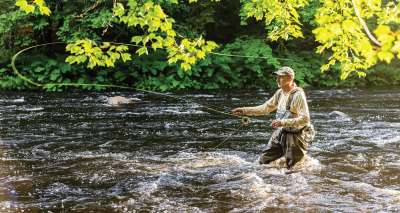
Inland Woods + Trails now also has a license with the Fund to manage recreational trails on the properties slated for the larger Forest Legacy conservation easement covering about 10,000 acres. One of them is the 3,800-acre Kendall Brook lot, stretching all the way from Bethel to Mt. Abram.
In fact, with all the various linkages accomplished by this acquisition, we have a defeat of the very fragmentation that these lots seemed to indicate on a map. Ecologically, these dabs of paint – once fixed in place with conservation easements or land preserves – allow the Presidentials to remain integrated with the Mahoosucs, the forest canopy continuous and stable, the rivers and watersheds of southwestern Maine clean and potable. The process by which the buy was made is a textbook model of how national and local conservationist groups can work together to accomplish more.
That next summit, it turns out, was not so insurmountable as it appeared in 2019 – but only because conservation organizations, like climbing partners, watch out for each other and know how to help.
A Mosaic of Habitats
Much of the Chadbourne Tree Farm will continue to be managed for timber harvest consistent with the generations of careful stewardship of the Chadbourne family. But within the suite of properties, a recent natural resources inventory identified exemplary natural communities needing special protection. For example, the Tumbledown Dick Mountain property harbors a mosaic of forest types not commonly found in such pristine condition, including dry oak-pine forest, oak-pine woodland, and cliff-gorge natural communities with small embedded areas of uncommon red pine-white pine forest and red pine woodlands. One small patch of red pine woodland has old-growth features and includes several pitch pines that appear to be at the edge of their range; tree cores revealed a 160-year-old red pine and a 125-year-old pitch pine. Fire scarring suggests fire historically was an important ecological process here. Ground cover includes lowbush blueberry and sheep laurel, and common herbs such as hairgrass (Deschampsia flexuosa), Pennsylvania sedge (Carex pensylvanica), shaven sedge (Carex tonsa), and rock polypody (Polypodium virginianum).
A Critical Corridor
The Chadbourne Tree Farm properties lie at the edge of Maine’s fabled western Maine Mountains region, and along with adjacent protected forests comprise the heart of the ecoregion known as the Northern Appalachian/Acadian Forest. Stretching both east-west along the Androscoggin valley, and north-south, the properties purchased by The Conservation Fund provide a critical linkage between the White Mountains and Mahoosuc Range and beyond. Maintaining the largely unfragmented nature of these forests protects important habitat for iconic species such as pine marten, moose, and black bear, and habitat for 34 northern woodland songbirds. Significant wildlife travel corridors exist both up and down the hillsides and mountains, along streams winding through woodlands and wetlands to the mainstem Androscoggin, and across the landscape on both sides of major roadways. Twenty-seven miles of riparian forest supporting critical wild brook trout habitat will be protected from development (see Northern Woodlands Spring 2021 for more on the region’s ecological significance and wild brook trout protection efforts).
This article and the accompanying infographic were made possible by grants from The Betterment Fund and Maine Timberlands Charitable Trust.


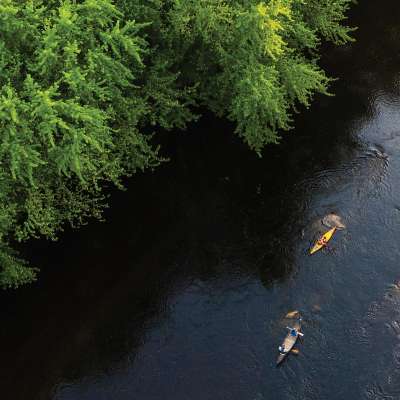
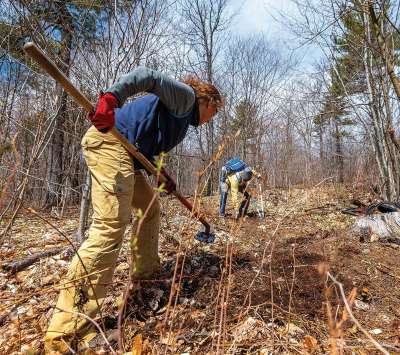
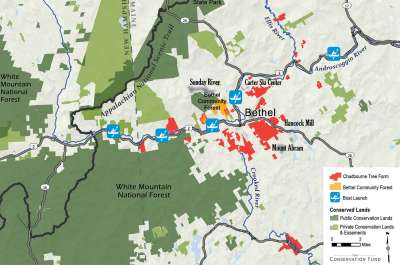
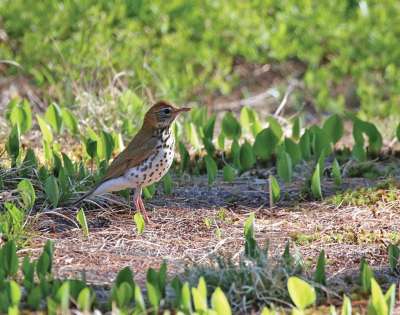
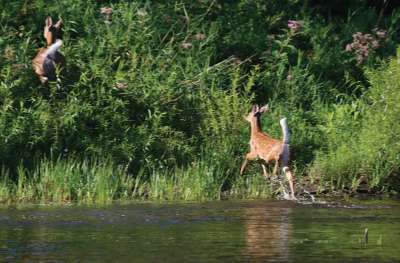
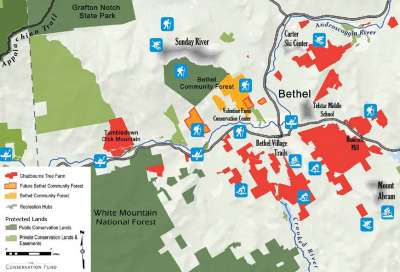
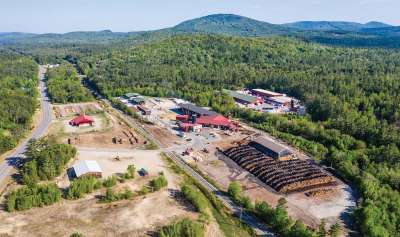
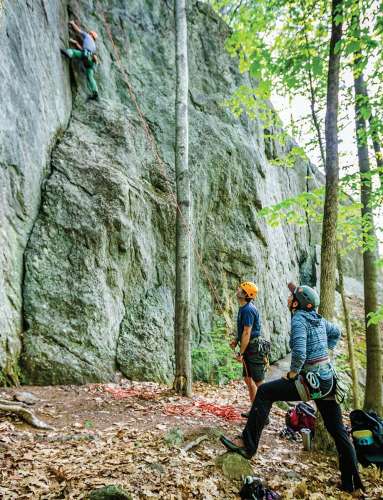
Discussion *